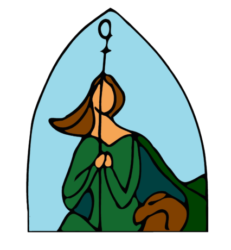‘They saw the child with his mother Mary and they bowed down and worshipped him. Then they….presented him with gifts of gold, frankincense and myrrh.” Matthew 2:1-12.
“Rather than getting more spoilt with age, as difficulties pile up epiphanies of gratitude abound.” Alain de Botton.
I had a minor epiphany recently, a revelation of seeing in a new way something I’d viewed in a different light for many years. It involved the badge of my grammar school, which had elements from the city’s coat of arms on it. At school in Nottingham, I’d been told that the three golden crowns on the badge represented the Holy Trinity and its rough wooden cross Shirewood Forest. It had also been suggested that the crowns are ducal coronets and a mark of the King’s approval with so many royals often coming for the good hunting in Sherwood Forest with an area still called the Dukeries today. What I didn’t realise, and have only discovered this Epiphany, is that the three crowns may be linked with the Magi in Matthew’s Gospel, who took symbolic gifts to the Christchild of gold, frankincense and myrrh.
Many carols sing of the figures known as the Three Kings as well as the Wise Men and they may not have existed at all, though their influence is extensive as they traditionally depict young, mature and older people from Europe, Africa and Asia. As Magi, priests of the Zoroastrian religion whose deity is the god of light Ahura Mazdā (hence Mazda light bulbs), Matthew’s account tells of their arrival in Jerusalem as they asked where the child born to be king was to be found. By doing so, they alerted King Herod, which led eventually to the Massacre of the Innocents as he ordered all baby boys under the age of two to be killed. However, there is little historical evidence for this either, though savagery was used by the Romans in enforcing their empire. By travelling on to find Jesus and then returning via a different route, the Magi linked both Jews and Gentiles in showing that the Light of the World had come to all humanity and not just a chosen race, age or background. That is sometimes lost today.
Those three kings were also the link between the crowns on my school badge and the mother of Emperor Constantine, St. Helena, who was thought to have been born in 242 CE in Colchester. She was the daughter of King Coel from whom the city gets its name and Nottingham may carry three golden crowns on its crest, like Colchester, because a later King Coelus was buried there. Helena recovered many artefacts of Christian significance, amongst them the relics of the Three Kings which eventually ended up in Cologne. There is a golden shrine in the Cathedral holding the bones of three men and, although their existence is doubted by some, the fact of the shrine’s existence and its importance as a place of pilgrimage for many today shows that truth is revealed in the story of the Magi for others.
The same is true here at St. Melangell’s, where I’m sometimes asked whether or not it troubles me that she is thought by some never to have existed. That may be the case, but would her church, shrine and story have developed and still be thriving today had she never lived? Clearly, elements of her tale may be exaggerated or misunderstood but perhaps the legacy of sanctuary, healing and hospitality that has endured here for centuries is the greatest testament to the truth of her existence. So, as Epiphany is marked once more, the church door has been chalked with this year’s date and the words Christus Mansionem Benedicat inviting Christ to bless this house of peace and hope as well as commemorating Caspar, Melchior and Balthazzar. As 2025 begins, may Epiphanytide bring revelations of truth and hope which will continue throughout the year – if we’re willing to seek them and even if they are sometimes only fully understood many years later!
With my prayers; pob bendith,
Christine, Priest Guardian.

